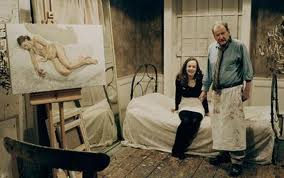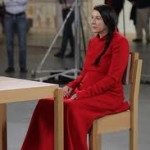Julia’s art performances
Julia rushes, freed after earning her high school diploma, diligently into her passion. Every Saturday night she presents, in the gallery of her parents, a new piece of art to the Rotterdam public.
Lucien Freud
 The first artist she plays with is inspired by the paintings of Lucien Freud. He uncompromisingly paints the human body. Freud’s work belongs to the contemporary art and neo-realism. The famous critic Herbert Read called him once “the Ingres of existentialism.” In addition to portraits and nudes, Freud also painted trees and plants. Often a dog or a plant featured on the paintings of people. Freud is also seen as an exponent of existentialism, the painted models seem not really present, they have a look focused inward. The viewing direction is generally to a point outside the painting. The nudes are often depicted in a very exhibiting position, genitals ask prominent attention. The work is therefore sometimes described as confrontational.
The first artist she plays with is inspired by the paintings of Lucien Freud. He uncompromisingly paints the human body. Freud’s work belongs to the contemporary art and neo-realism. The famous critic Herbert Read called him once “the Ingres of existentialism.” In addition to portraits and nudes, Freud also painted trees and plants. Often a dog or a plant featured on the paintings of people. Freud is also seen as an exponent of existentialism, the painted models seem not really present, they have a look focused inward. The viewing direction is generally to a point outside the painting. The nudes are often depicted in a very exhibiting position, genitals ask prominent attention. The work is therefore sometimes described as confrontational.
Hesther Scheurwater
The next artist Julia is influenced by is Hesther Scheurwater. She plays with eroticism and photos of herself, who leaves the viewer puzzled and oppressive by the exaggeration of her work. Hester Scheurwater (Hendrik Ido Craft, 1971) is a Dutch artist. She studied at the Amsterdam School of the Arts and at the Royal Academy of Art in The Hague. In the work of Scheurwater – photography, short film and installations – contain often references to lust and eroticism. Hester’s work is exhibited at the Brooklyn Museum in New York and at the Photo Festival Naarden. In the Stedelijk Museum Zwolle end of 2010 a full exhibition of her work was shown. Scheurwater gained international fame with her self-portraits on Facebook that were invariably removed for alleged pornographic content by the social networking service.
Marina Abramović
 Then Julia comes in contact with the Serbian artist Marina Abramović, an artist who deals with video art and performance. Van March 14 to May 31, 2010 the Museum of Modern Art in New York dedicated a retrospective to the work titled “Marina Abramović: The Artist is Present.” The exhibition was organized by curator Klaus Biesenbach and featured documentation and older performances by Abramović and Ulay. It was the first retrospective at MoMA which was entirely dedicated to performance art, and with more than 850,000 visitors one of the most successful shows in the history of the museum. On this occasion Abramović conducted herself in a new performance, titled “The Artist is Present.” For this performance, which like the exhibition took about three months, the artist sat during the opening hours of the MoMA in silence on a chair in the atrium of the museum. Visitors could sit in a chair across Abramović to watch her silently in the eye as long as they pleased.
Then Julia comes in contact with the Serbian artist Marina Abramović, an artist who deals with video art and performance. Van March 14 to May 31, 2010 the Museum of Modern Art in New York dedicated a retrospective to the work titled “Marina Abramović: The Artist is Present.” The exhibition was organized by curator Klaus Biesenbach and featured documentation and older performances by Abramović and Ulay. It was the first retrospective at MoMA which was entirely dedicated to performance art, and with more than 850,000 visitors one of the most successful shows in the history of the museum. On this occasion Abramović conducted herself in a new performance, titled “The Artist is Present.” For this performance, which like the exhibition took about three months, the artist sat during the opening hours of the MoMA in silence on a chair in the atrium of the museum. Visitors could sit in a chair across Abramović to watch her silently in the eye as long as they pleased.
Sustainable Artist Foundation
When Julia gives a presentation together with the Rotterdam artist Kees Verburg, the painting titled ‘the heavy burden of modernity’ is shown. Her father, Henk van Wijnen-Swarttouw, is impressed by the possibilities offered. After this event, he decides to establish the so called ‘Sustainable Artist Foundation’. Can this brand new organization, the S.A.F., play a significant role in society as Henk believes it will be able to do? Can Julia become the leader of this organisation, The Game Changer. Will this artistic collaboration between father and daughter work out for the good?
